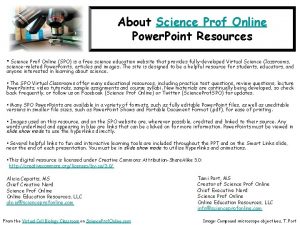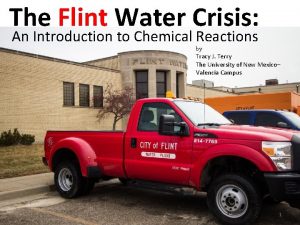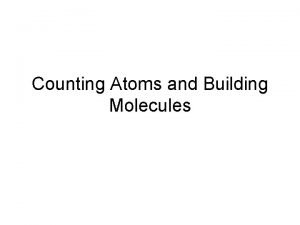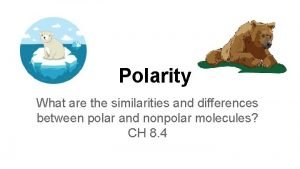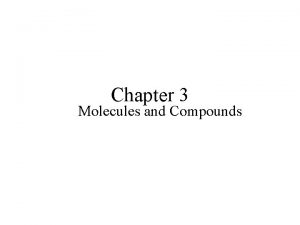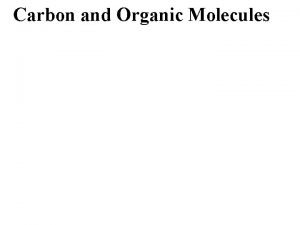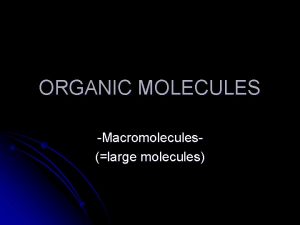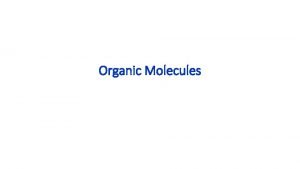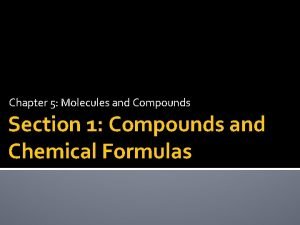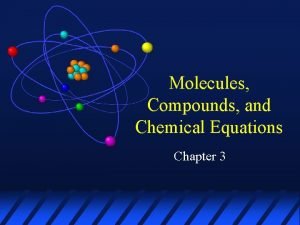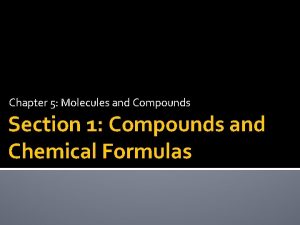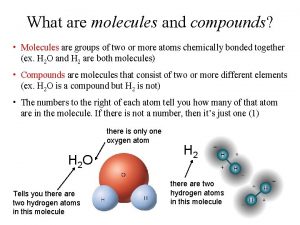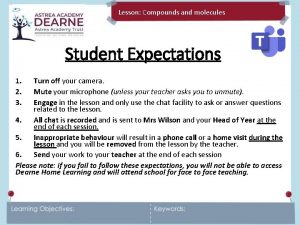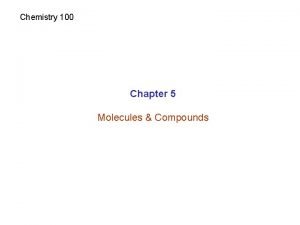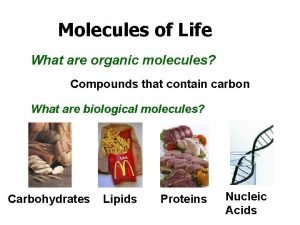Chapter 4 Compounds and Molecules 4 1 Compounds














- Slides: 14

Chapter 4 Compounds and Molecules

4. 1 Compounds and Molecules • What are compounds? • Table salt is a compound made of two elements, sodium and chlorine.

4. 1 Compounds and Molecules • Chemical bonds distinguish compounds from mixtures. • Chemical Bonds- Are the attractive forces that hold different atoms or ions together in compounds • Mixtures are made of different substances that are just placed together. • A compound always has the same chemical formula.

4. 1 Compounds and Molecules • Chemical structure shows the bonding within a compound. • Chemical Structure-the arrangement of bonded atoms or ions within a substance • Bond Length-The average distance between the nuclei of two bonded atoms • Bond Angle-The angle formed by two bonds to the same atom

4. 1 Compounds and Molecules • Some models give you an idea of bond lengths and angles • Space filling models show the space occupied by atoms • Compounds with network structures are strong solids

4. 1 Compounds and Molecules • Some networks are made of bonded ions • Some compounds are made of molecules • The strength of attractions between molecules

4. 2 Ionic and Covalent Bonds • What holds bonded atoms together? • The outermost energy level of a bonded atom is full of electrons • Atoms bond when their valence electrons interact • Generally, atoms join to form bonds so that each atom has a full outermost energy level

4. 2 Ionic and Covalent Bonds • Bonds can bend and strech without breaking • Ionic Bonds- are formed between oppositely charged ions • Ionic bonds are formed by the transfer of electrons • Ionic compounds are in the form of networks, not molecules • When melted or dissolved in water, ionic compounds conduct electricity

4. 2 Ionic and Covalent Bonds • Metallic Bonds- a bond formed by the attraction between positively charged metal ions and the electrons around them • The atoms in metals like copper form metallic bonds • Covalent Bond- a bond formed when atoms share one or more pairs of electrons

4. 2 Ionic and Covalent Bonds • Atoms joined by covalent bonds share electrons • Atoms may share more than one pair of electrons • Atoms do not always share electrons equally

4. 2 Ionic and Covalent Bonds • Polyatomic Ion- an ion made of two or more atoms that are covalently bonded and act like a single ion • There are many polyatomic ions • Parentheses group the atoms of a polyatomic ion • Some polyatomic anion names relate to their oxygen content

4. 3 Compound Names and Formulas Naming Ionic Compounds • Names of ionic compounds include the ions of which they are composed: • The cation is listed first and is named as usual; then name the anion adding the –Ide suffix – Example: Sodium chloride • Determining the charge transition metal cation

4. 3 Compound Names and Formulas Naming covalent compounds • Name the component elements in order. • Numerical prefixes are used to name covalent compounds of two elements. Table 4. 7 pg. 126 • Example: Name N 2 O 4 • Dinitrogen tetraoxide • If there was only one atom of the first element it would not have a prefix

4. 3 Compound Names and Formulas • Empirical Formula- the simplest chemical formula of a compound that tells the smallest whole-number ratio of atoms in the compound • A compound’s simplest formula is its empirical formula • Different compounds can have the same empirical formula • Molecular Formulas- a chemical formula that reports the actual numbers of atoms in the molecule of a compound
 Organic molecules vs inorganic molecules
Organic molecules vs inorganic molecules Solution
Solution All compounds are molecules
All compounds are molecules Science prof online
Science prof online Ionic vs covalent vs metallic
Ionic vs covalent vs metallic Chapter 2 atoms molecules and ions
Chapter 2 atoms molecules and ions Ionic compound properties
Ionic compound properties 7 ionic and metallic bonding practice problems
7 ionic and metallic bonding practice problems Chapter 3 molecules of life
Chapter 3 molecules of life What is the relationship between atoms and elements
What is the relationship between atoms and elements Classify the following unbalanced chemical equations
Classify the following unbalanced chemical equations Solid liquid and gas particles
Solid liquid and gas particles Chiral achiral
Chiral achiral How can you count atoms and molecules
How can you count atoms and molecules Polar and nonpolar similarities
Polar and nonpolar similarities



